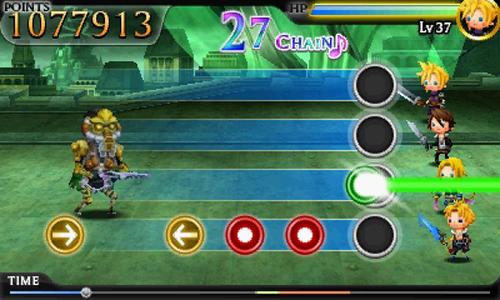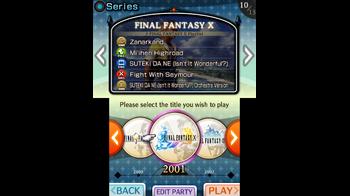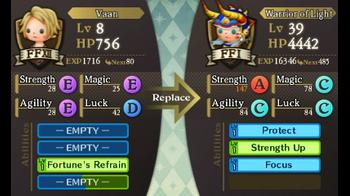Theatrhythm Final Fantasy Review
Love it or hate it, there’s no denying that nostalgia is a very powerful thing. That couldn’t be more evident than in Theatrhythm Final Fantasy—a brand new whimsical blend of rhythm game and RPG from Square Enix’s own top tier production studio.
Truth be told I wasn’t exactly excited when the game was revealed last year, which is something I think a lot of people can agree on. What, with its super-deformed mascot style character designs and rhythm action game premise it’s no secret that I was among the doubters. Months went by with various previews here and there, and I still was not convinced—that was until I placed my hands on it for the very first time.
You see, Theatrhythm Final Fantasy (here on abbreviated as TRFF) is a game of absolute wonder. The first time I ever played the game I was unexpectedly moved to tears. The result of remembering a time much more innocent for both myself and the Final Fantasy series as a whole had me craving for more.

The story of TRFF is quite simplistic—in fact it’s fairly non-existent for the most part outside of a brief prologue and subsequent epilogue upon getting through to a certain point in the game. If you played either of the Dissidia games you’ll be familiar with the conflict between Cosmos and Chaos. The space that exists between them is called Rhythm and contains a crystal that creates music. But like all good things, Chaos attempts to end the harmony and thus the power of the crystal is thrown into disarray. In order to restore the balance, Cosmos calls upon warriors of every era in order to collect Rhythmia, which is said to revive the crystal once again.
Outside of that, the game offers no cutscenes, no character development, or really any dialogue. But that’s fine—it’s a rhythm action game after all. The RPG elements lie not within any sort of story-telling, but within the gameplay systems themselves.
Rhythm games live and die by their gameplay, and TRFF has no problem standing up with some of the greatest. Different modes offer unique variety for those who want to experience music from the entire series, single out specific challenge songs, or even face more difficult tracks in the game’s Chaos Shrine. Upon starting the game by selecting Music Play for the first time, you’re brought right into the Series mode, which allows you to pick any Final Fantasy title I through XIII. From there you’ll be taken on a musical journey through that given game beginning with a prologue, field, battle, event scene and finally an epilogue track. The main menu also includes two other options including Street Pass features and a Museum mode for viewing collectables.
By completing each game in Series mode, Challenge mode will become unlocked which gives you the ability to play each of the three main song types individually: Battle Music Stage, Field Music Stage and Event Music Stage.
Battle Music Stages include songs such as The Fight with Seymour (FFX), Battle I (FFIX), and of course One-Winged Angel (FFVII). Field Music Stages include the likes of Terra’s Theme (FFVI), Ronfuare (FFXI) and The Sunleth Waterscape (FFXIII), and Event Music Stages include themes such as Celes’ Theme (FFVI), Suteki da ne (FFX) and Waltz to the Moon (FFVIII).
Each song in the Challenge mode is accompanied by various difficulty levels. The main three include Basic, Expert and Ultimate with the later two being available from the beginning. By achieving an A rank or higher in Expert mode, you’ll unlock the final mode.
The meat of the gameplay is of course in the rhythm techniques needed to complete each song. Each type of song takes advantage of various taps and swipes which center around simple red circle taps, to green taps that must be held for a given time, and yellow arrows which must be swiped in specific directions. During the middle of a stage a special Feature Zone will appear. Successfully hitting the notes in said zone will enter your characters into a special mode depending on the type of level you're on. Field stages produce a chocobo, battle stages can produce summons and event stages allow for an extension of the scene.
The timing and frequency of the rhythm icons depends on which difficulty level you choose to play at. Completing each song gives you a rank, SSS through F, depending on how well you hit each note and scored points ranging from critical to missed. Missing a note will affect your character's HP, so be careful. As per the game’s story, you also earn Rhythmia and experience points which will in turn net you unlockables from time to time.
The experience points system works similar to your typical RPG—earn enough and your characters will level up. TRFF lets you choose 4 party members at once, including a designated party leader. For the sake of the review, I decided to go with Cloud (Leader), Squall, Terra, and Tidus, but characters from each Final Fantasy in the series are represented so really, you can pick whoever you’d like. The four stats that each character can have include Luck, Strength, Magic and Agility. Each of these can vary in efficiency depending on the character, but it’s best to try out all of them to see which best fits your playing style.
While leveling up, you can also equip each character with various active and passive abilities and items that are both stock and can be earned throughout the game. These come into use during the actual music stages to give you advantages such as lowered damage from missing notes, or perhaps a Pheonix Down to restore HP if you’ve managed to KO your party leader. If you decided to venture unequipped, however, you will earn yourself a stoic bonus at the end of each song, which nets you a nice set of extra points that count toward your final ranking.
No RPG would be complete without a host of unlockables and Theatrhythm has no shortage of them. By gathering certain amounts of Rhythmia, extra “Encore” songs are unlocked in the challenge mode. These include fan favorites such as Dancing Mad (FFVI), Blinded by Light (FFXIII) and Those Who Fight (FFVII). Each of these tracks can be played in all three difficulty modes. Once you obtain 30,000 Rhythmia or more, you’ll start unlocking Chaos Scores. Also available in the challenge mode, these tracks feature only one difficulty and include songs such as Battle I (FFIV), Mambo de Chocobo (FFV) and Something to Protect (FFIX).
The Chaos Shrine, which opens up later on in the game, also features its own set of unlockables. For those looking for a hardcore rhythm game experience, search no more. The Chaos Shrine requires players to unlock each next set of two mystery songs, called Chaos Notes, by completing the previous ones. The numbers displayed on the Chaos Notes indicate the song and difficulty level you’ll be facing – and they can get pretty tough. Around the 40th one or so, I encountered ridiculously fast tap notes, rotating yellow arrows and overall frustration. Truly only the greatest of rhythm game masters would be brave enough to attempt those.
Through the game's Chaos Shrine, you can also join other players in a multiplayer session of sorts. Three other players and you can take on challenges together with the highest scoring player's ranking counting for the entire group.
Each Chaos Note features a field and battle stage, with various boss encounters hidden in the latter. Grinding through specific ones, which can be revealed by equipping Libra on one of your party members, can help you discover rare items – including character shards.
Many different colors of character shards can be collected throughout the game. Collect 8 of one color and you’ll unlock a brand new character to place in your party. Most of these include some of the series secondary characters such as Locke, Seifer, Yuna, Vivi and more. Aside from unlocking them in the Chaos Shrine, shards also come available from simply gathering Rhythmia.
Fans of collectathons will be pleased to know that characters and new songs aren’t the only thing you can find in TRFF. Trading card-like items known as CollectaCards, music for the movie player, and additions for your own player profile can be obtained during your normal playthrough. CollectaCards can also be unlocked with specific passwords, most of which can be found online. Trophies also play a big part in the game, which are earned by completing various milestones.
The sheer amount of content doesn’t stop there though. Square Enix has made the game so massive; it just couldn’t all fit on one cartridge. As such, and as with any recent rhythm or music game, it only makes sense to give players a reason to keep returning and the execution of downloadable content in TRFF has proved a successful one. From release day, a multitude of extra songs have been made available for purchase directly from the game’s main menu – all for the price of $.99 a song. Not too much to ask for a full-featured Field or Battle Music Stage.
Nearly every piece of content that Japan has seen has been released overseas, including Somnus from the as of yet unreleased Final Fantasy Versus XIII. There is, however, one track that remains elusive which is We Have Arrived from Final Fantasy Type-0. While that game (and even Versus XIII) remain unannounced for the west, such a glaring omission is somewhat concerning given the game’s absence. Ironically, SEA has officially released a screenshot from the Type-0 stage, but one wonders if that was a mistake? That aside, this is probably the first game I've actively enjoyed purchasing DLC for.
From a presentation standpoint, Theatrhythm Final Fantasy is absolutely gorgeous in its own way. The cute mascot style character designs lifted from Kingdom Hearts Mobile do well to create a cohesive theme in a franchise that varies so greatly in art design between entries. Each stage has been catered to reflect its respective Final Fantasy depending on the song, with vibrant, faithful background recreations of the originals.
The inclusion of the original sound versions for each song (except Chaos Shrine and Mt. Gulg) is also a welcome decision – and one that doesn’t cheapen the experience in any way. Various Final Fantasy arrangements play during the game’s menus, which is also a nice touch.
The game’s localization is where TRFF hits a slight snag. Several of the older Final Fantasy titles still retain Japanese text during the Event Music Stages. Also, a couple songs including Melodies of Life, which does have an official English language version, were left in Japanese. I can somewhat understand that re-editing the FMVs would be difficult, but it just seems like a glaring mistake to leave Final Fantasy IX’s signature vocal theme untouched.
The only other complaint I can think of goes back to some of the game's unlockables. The amount of time needed to obtain the rest of the songs and characters is a bit too high in some areas. For example, I've put in over 22 hours into my playthrough and am still missing four of the Chaos songs. For a rhythm game that's simply unacceptable.
Regardless, Theatrhythm Final Fantasy still stands above the rest. While general enjoyment is somewhat dependent on whether you're a Final Fantasy fan or not, it's still a competent rhythm game nonetheless. Above all, it’s a fitting tribute to 25 years of the series, and one of the best Square Enix games in recent years – and that’s all it really needs to be.
Disclaimer: This review was based off final retail code of the English Nintendo 3DS version of Theatrhythm Final Fantasy provided by Square Enix.



